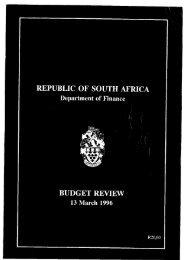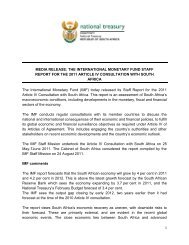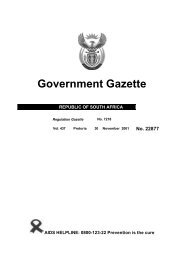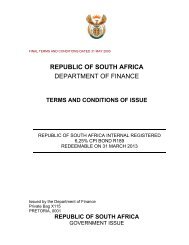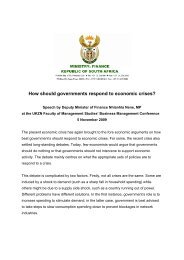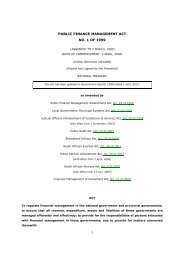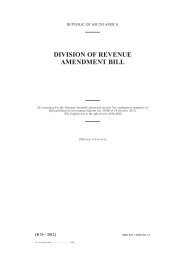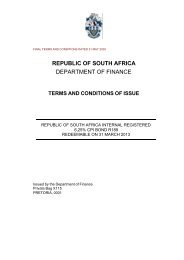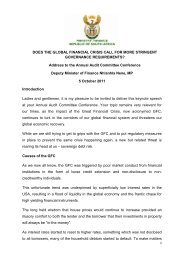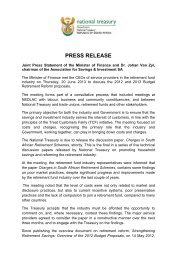1998 SOUTHERN AFRICA ECONOMIC ... - National Treasury
1998 SOUTHERN AFRICA ECONOMIC ... - National Treasury
1998 SOUTHERN AFRICA ECONOMIC ... - National Treasury
You also want an ePaper? Increase the reach of your titles
YUMPU automatically turns print PDFs into web optimized ePapers that Google loves.
S O U TH A F R I C A<br />
suggest that the number of tourists could double between 1995<br />
and 2000 - in 1997 alone, tourist arrivals we re up 21.5 perc e n t<br />
on the previous ye a r. South Africa re c e i ved ap p rox i m a t e ly one<br />
million visitors from overseas in 1997, and three million trave l l e r s<br />
f rom the African mainland (for the nine months up to October<br />
1 9 9 7 ) .The fastest growing segment of tourism in South Africa is<br />
eco-tourism which shows great potential as a source of fo re i g n<br />
exchange and inve s t m e n t ,e s p e c i a l ly if South Africa is viewed as<br />
p a rt of a richly diverse re g i o n .<br />
I n f r a s t r u c t u re<br />
South Africa is largely semi-arid and prone to err a t i c,<br />
u n p redictable droughts and floods. M a ny large storage dams<br />
h ave been constructed to regulate the naturally variable flow of<br />
r i ve r s , and to ease water transfers between catchments. A n<br />
i m p o rtant hy d roelectric scheme is the Lesotho Highlands Wa t e r<br />
P ro j e c t ,a joint ve n t u re with Lesotho, the first phase of which<br />
was opened in Janu a ry <strong>1998</strong>. Another regional project is the<br />
Komati River pro j e c t , a joint undertaking with Swaziland. T h e<br />
RDP water and sanitation programme aims to ensure that 8.9<br />
million additional people have access to safe water.<br />
South Africa is committed to increase access to electricity fro m<br />
the present 50 percent to 72 percent of households by the ye a r<br />
2000 and in 1997, 271,240 houses re c e i ved access to electricity.<br />
C u rre n t ly, South Africa supplies more than half of all electricity<br />
generated in A f r i c a .Sasol provides 47 percent of South A f r i c a í s<br />
liquid fuel, which is processed from coal and crude oil.<br />
South A f r i c a ’s modern transport system plays an important ro l e<br />
in the national economy and in the economies of several other<br />
African states. S everal countries in southern Africa use the<br />
South African transport infrastructure to move their import s<br />
and export s .The national road system connects all the major<br />
c e n t res in the country to one another and to neighbouring<br />
c o u n t r i e s .The system covers ap p rox i m a t e ly 7,000 km of ro a d s ,<br />
of which about 660 km are toll ro a d s .These are serviced by 18<br />
toll plazas. Road transport accounts for ro u g h ly eight percent of<br />
all freight being transported by land in South A f r i c a .The railw ay<br />
system is we l l - d eve l o p e d ,c overing about 36,000 km of track, o f<br />
which almost half is electrified.<br />
Po rtnet controls seven of the 16 biggest ports in the gre a t e r<br />
southern A f r i c a .T h ey are Richards Bay, D u r b a n ,East London,<br />
Po rt Elizabeth, Mossel Bay, C ape Town and Saldanha Bay. T h e<br />
p o rts of Durban, Po rt Elizabeth and Cape Town provide large<br />
container terminals for deep-sea and coastal container traffic.<br />
Durban is the largest and busiest port in sub-Saharan A f r i c a ,a n d<br />
is curre n t ly undergoing a major expansion programme to<br />
i n c rease its cargo vo l u m e s .<br />
The A i r p o rts Company operates nine state airport s , t h ree of<br />
which (namely Jo h a n n e s b u r g , Durban and Cape Town) are<br />
classified as international airport s . The national airline, S o u t h<br />
African A i r w ays (SAA) serves both domestic and international<br />
ro u t e s .P r i v a t e ly run airlines compete with SAA.<br />
South Africa has a re l a t i ve ly we l l - d eveloped telephone netwo r k ,<br />
with nearly 90 telephone lines for eve ry 1,000 inhabitants.<br />
H oweve r,while the commercial centres have a telecom netwo r k<br />
that is comparible with “ f i r s t - world” standards the rural are a s<br />
a re, in comparison, p o o r ly serv i c e d . One of the goals of the<br />
government is there fo re to provide four million new telephone<br />
connections to people in historically disadvantaged<br />
c o m mu n i t i e s . Te l ko m , South A f r i c a ’s telecommu n i c a t i o n s<br />
c o m p a ny, o f fers telegram serv i c e s , telex and teletex serv i c e s ,<br />
public e-mail and electronic data i n t e rc h a n g e, enhanced facsimile<br />
s e rv i c e s , a telephone confe re n c e f a c i l i t y, and a nationwide<br />
n e t work of microw ave channels to link the South A f r i c a n<br />
B roadcasting Corporation and M-Net telev i s i o n studios and<br />
t r a n s m i t t e r s .O p t i c a l - f i b re networks carrying voice and data<br />
h ave been established in and between all major centre s . S o u t h<br />
Africa is the Internet hub for the Southern African re g i o n ,w i t h<br />
over 70 Internet service prov i d e r s .Access to the Internet in<br />
South Africa is curre n t ly growing at a rate of 10 percent a<br />
m o n t h .<br />
Cellular phones have proved to be extre m e ly popular in South<br />
A f r i c a .T h e re are two cellular telephone networks in South<br />
A f r i c a ,and in March <strong>1998</strong> South Africa had ap p rox i m a t e ly 1.8<br />
million cellular phone subscribers.<br />
E C O N O M I C O V E R V I E W<br />
I n t ro d u c t i o n<br />
South Africa has a modern, we l l - d i versified economy in which<br />
a g r i c u l t u re, m i n i n g ,s e c o n d a ry industry (manu f a c t u r i n g ,e l e c t r i c i t y,<br />
g a s , water and construction), c o m m e rce and a broad structure<br />
of service establishments contribute to the wealth of the nation.<br />
The market driven and export-oriented economy is based on<br />
private enterprise and ow n e r s h i p.The industrial sector is seen<br />
as the major generator of economic growth in the country.<br />
In 1996,the South African government adopted a new economic<br />
policy framewo r k , entitled Grow t h , E m p l oyment and<br />
R e d i s t r i b u t i o n ,or GEAR.The GEAR document puts fo r w a rd a<br />
medium-term strategy for achieving higher grow t h , c re a t i n g<br />
m o re employment opportunities and achieving higher grow t h ,<br />
c reating more employment opportunities and achieving the<br />
o b j e c t i ve of re d i s t r i b u t i o n .The core elements which make up<br />
GEAR include: a faster reduction in the fiscal deficit; a gradual<br />
reduction of tariffs; a speeding up the restructuring of state<br />
a s s e t s ; an expansionary infrastructure pro g r a m m e ; l a b o u r<br />
m a r ket flexibility within the collective bargaining system; and an<br />
expansion of trade and investment flows in Southern A f r i c a .<br />
Recent Macro-Economic Developments<br />
Real GDP is estimated to have grown by 3.2 percent in 1996,<br />
c o m p a red with 3.4 percent in 1995. H oweve r, economic activity<br />
s u b s e q u e n t ly slackened and the growth in the real GDP<br />
declined to only 1.7 percent in 1997. In the second half of 1997<br />
output growth slowed down even more and annualised output<br />
g rowth in the last six months was below 1 perc e n t .<br />
The sudden depreciation of the Rand in 1996 and the various<br />
policy responses to that event had a powerful influence on<br />
economic development in 1997. During the midst of<br />
d e p re c i a t i o n ,u n c e rtainties we re created by unfounded rumours<br />
about the Pre s i d e n t ’s health and speculation re g a rd i n g<br />
liberalisation of exchange controls on re s i d e n t s , and this<br />
fo s t e red expectations of rising inflation.The currency we a k n e s s<br />
emphasised the need to secure a better balance in the economy<br />
b e t ween aggregate demand and aggregate supply in order to<br />
re s t o re investors’ confidence and pre p a re the way fo r<br />
sustainable strong economic growth in the longer run.<br />
G rowth in gross domestic expenditure, which reached five<br />
p e rcent in 1995, declined to 2.7 percent and 1.4 percent in 1996<br />
and 1997 re s p e c t i ve ly. C o m p a red to output growth of 3.4<br />
p e rc e n t ,3.2 percent and 1.7 percent for 1995, 1996 and 1997<br />
re s p e c t i ve ly, this confirms that the last two years have<br />
contributed to a more balanced economy with re g a rd to<br />
a g g regate demand and supply.<br />
The adjustment process of the past two years had negative<br />
s h o rt-term effects which we re unavoidable if the long-run grow t h<br />
c apacity of the economy was to be stre n g t h e n e d .These included<br />
a short-term slow d own in the rate of real income grow t h ,a n d ,<br />
the decline in domestic employment levels as producers became<br />
i n c re a s i n g ly cost-conscious and needed to raise efficiency in<br />
their business to become internationally more competitive.<br />
These short-term adjustment problems we re aggravated by the<br />
u n c e rtainties created by the economic and financial pro b l e m s<br />
74



